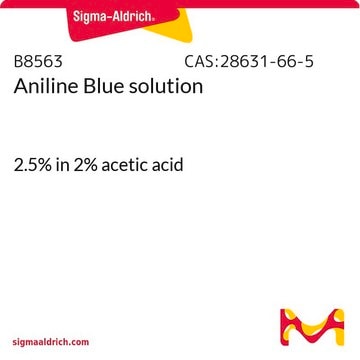95290
Methyl Blue
for microscopy (Bot., Hist.), indicator (pH 9.4-14.0)
Synonyme(s) :
Acid blue 93, Aniline blue water soluble, Cotton blue, Poirriers blue, Water blue
About This Item
Produits recommandés
Qualité
for microscopy (Bot., Hist.)
indicator (pH 9.4-14.0)
Niveau de qualité
Forme
powder or crystals
pH
9.4-14
Solubilité
water: 0.01 g/10 mL, blue to very deep blue
εmax
≥200 at 310-320 nm
≥400 at 595-605 nm
Application(s)
diagnostic assay manufacturing
hematology
histology
Température de stockage
room temp
Chaîne SMILES
[Na+].[Na+].OS(=O)(=O)c1ccc(Nc2ccc(cc2)\C(c3ccc(Nc4ccc(cc4)S([O-])(=O)=O)cc3)=C5/C=CC(\C=C5)=N/c6ccc(cc6)S([O-])(=O)=O)cc1
InChI
1S/C37H29N3O9S3.2Na/c41-50(42,43)34-19-13-31(14-20-34)38-28-7-1-25(2-8-28)37(26-3-9-29(10-4-26)39-32-15-21-35(22-16-32)51(44,45)46)27-5-11-30(12-6-27)40-33-17-23-36(24-18-33)52(47,48)49;;/h1-24,38-39H,(H,41,42,43)(H,44,45,46)(H,47,48,49);;/q;2*+1/p-2
Clé InChI
MCPLVIGCWWTHFH-UHFFFAOYSA-L
Vous recherchez des produits similaires ? Visite Guide de comparaison des produits
Description générale
Application
- to stain leaf disks for callose visualization within the cells
- to incubate cells for 4′,6-diamidino-2-phenylindole (DAPI)/septa staining
- as a marker for β-(1-3)-d-glucans or acidic phloroglucinol for the detection of callose and lignin
- in Mann′s stain as it involves a methyl blue-eosin mixture
Code de la classe de stockage
13 - Non Combustible Solids
Classe de danger pour l'eau (WGK)
WGK 2
Point d'éclair (°F)
>572.0 °F - Pensky-Martens closed cup
Point d'éclair (°C)
> 300 °C - Pensky-Martens closed cup
Équipement de protection individuelle
dust mask type N95 (US), Eyeshields, Gloves
Choose from one of the most recent versions:
Déjà en possession de ce produit ?
Retrouvez la documentation relative aux produits que vous avez récemment achetés dans la Bibliothèque de documents.
Les clients ont également consulté
Notre équipe de scientifiques dispose d'une expérience dans tous les secteurs de la recherche, notamment en sciences de la vie, science des matériaux, synthèse chimique, chromatographie, analyse et dans de nombreux autres domaines..
Contacter notre Service technique








